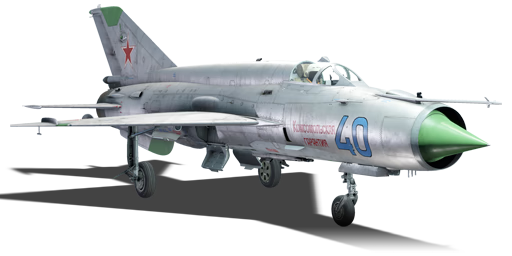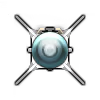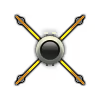



In 1972, in parallel to the MiG-21SMT and ST variants, a full overhaul of the MiG-21 airframe was being developed around the new Tumansky R-25 engine, which promised a thrust-to-weight ratio of over 1 on full second-stage afterburner when mated to a lightened MiG-21 airframe. The resulting design was given updated avionics and other modernizations, before entering service as the MiG-21bis, the ultimate culmination of the third-generation Fishbed. The MiG-21bis was quickly adopted in the USSR by both the PVO and the VVS, with one minor difference for the two operators. The PVO-flown MiG-21bis was fitted with a Lazur-M GCI (Ground Controlled Interception) guidance system, whereas the VVS-operated variant had a Polyot-OI instrument landing and guidance system outfitted, with the only visual difference between the two variants being a single small antenna under the forward fuselage. The two variants in export were respectively designated as the MiG-21bis Lazur-M (Fishbed-L) and the MiG-21bis-SAU (Fishbed-N) to differentiate them.
Introduced in Update "New Power", the MiG-21bis is the ultimate Soviet development of the MiG-21. It looks roughly the same as the MiG-21S and MiG-21MF, both being third-generation MiG-21 models with search radars, internal GSh-23 cannons, and pronounced fuselage spines. However, the similarities end there, as under the hood, the MiG-21bis is a completely new beast. The most important upgrades are the new addition of the new R-25-300 engine, giving this aircraft increased thrust over its older variants. The other major upgrade to the MiG-21bis is its fire control system, which now allows it to not only use the R-13M1 missile, but also the ability to mount the APU-60-2 pylons which can carry twice as many R-60Ms on one hardpoint. All in all, people who enjoyed previous Fishbeds for their incredible dogfight performance, and built upon the mastery of working around both the disadvantages and advantages of the Fishbed airframes, will find this aircraft to be very enjoyable to fly, as what it lacks in BVR and strong missiles at its battle rating, are easily outweighed by the lightened airframe and relatively powerful engine allowing it to punish most planes that engage it in unconditional close-range dogfighting at low altitude, bar some specific planes.
flaps
flaps
flaps
brake
| Belt | Belt filling | Armor penetration (mm) at a distance: | |||||
|---|---|---|---|---|---|---|---|
| 10 m | 100 m | 500 m | 1000 m | 1500 m | 2000 m | ||
| HEFI-T/AP-I/HEF-I | 31 | 29 | 21 | 15 | 10 | 7 | |
| HEF-I/AP-I/AP-I/AP-I | 31 | 29 | 21 | 15 | 10 | 7 | |
| HEFI-T/HEF-I/HEFI-T/HEF-I/AP-I | 31 | 29 | 21 | 15 | 10 | 7 | |
| AP-I/HEF-I/HEF-I | 31 | 29 | 21 | 15 | 10 | 7 | |
| Name | Weight | Slot | ||||
|---|---|---|---|---|---|---|
| 75.3 kg |  |  |  |  | ||
| 75.3 kg |  |  |  |  | ||
| 90.6 kg |  |  |  |  | ||
| 44 kg |  |  |  |  | ||
| 2 × | 88 kg |  |  | |||
| 235 kg |  |  |  |  | ||
| 16 × | 110.2 kg |  |  |  |  | |
| Drop tank (490 liters.) | 49 kg |  |  |  | ||
| 32 × | 225.5 kg |  |  | |||
| 4 × | 456 kg |  |  | |||
| 227 kg |  |  | ||||
| 508.3 kg |  |  | ||||
| 374 kg |  |  | ||||












Flight performance | |
|---|---|
Survivability |
|---|
Weaponry | |||
|---|---|---|---|